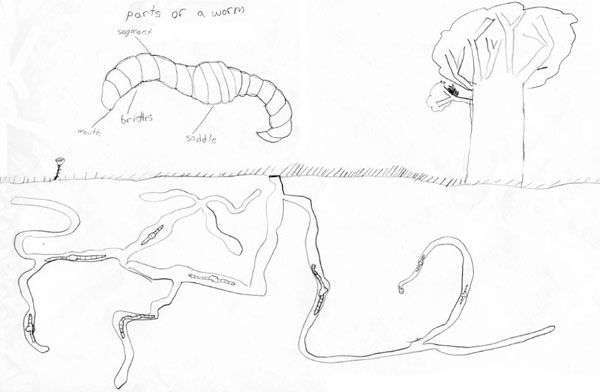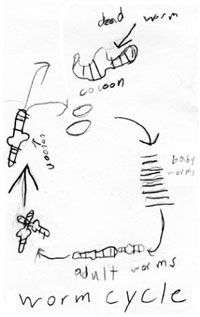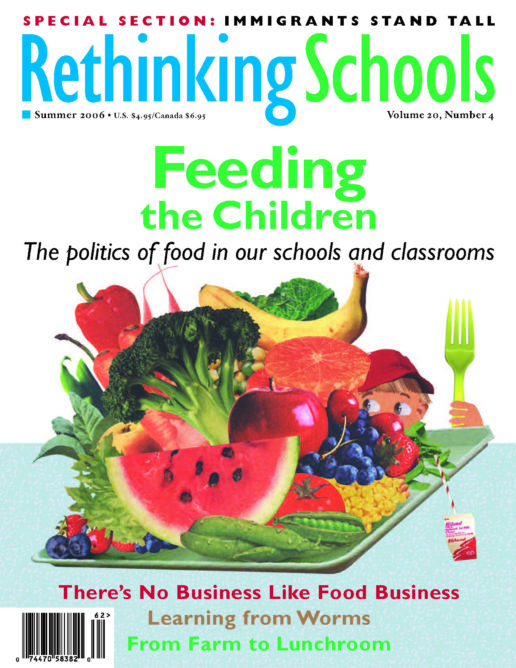Yuck! Worms Are Disgusting!
Ecological and social lessons from a classroom worm bin
Illustrator: Sanchez Elementary School/Johnathan and Josue

Each September the reaction in my 4th grade classroom is predictable:
“Worms? Gross! Why can’t we have a real classroom pet, like a rabbit or a guinea pig?”
Rabbits, guinea pigs, turtles, and other more conventional pets are fine, but there are many reasons why I prefer setting up a redworm compost bin in my classroom each year. Worms require much less daily care and they provide endless opportunities for learning about cycles, systems, decomposition, food, soil, science inquiry, and basic ecological connections.
More important, I find that having a worm bin helps children develop empathy, combat stereotypes, and gain respect for all forms of life on earth. These concepts overlap nicely with my goals for creating a meaningful learning environment and building a classroom community.
Our classroom “vermicomposting system,” which is simply a five-gallon plastic box with a lid and holes drilled in the bottom, sits off the floor a few inches over another lid that collects drips. The bin provides a home for more than 1,000 California redworms, a variety of earthworm that can be ordered online from a number of different worm farms (see resource list) or purchased at a local plant nursery.
During the first week or two of school, the students and I prepare the bin for the worms and make predictions about what will happen in the worm bin. I ask the students what facts about worms they already know, and I make a chart for the wall. I also write down what they are interested in finding out. Inevitably, someone states that worms can be cut in half to make two new worms; I respond by saying I have heard cutting worms kills them, and we agree to write the child’s statement instead in the question column of the chart. Later I will bring in books that teach the children that, in fact, cutting worms in half results in the death of the worm.
The day I bring the worms to school we sit in a circle and shred enough newspaper to fill the box. Then we add water, mixing with our hands until it feels as moist as a damp sponge. This serves as bedding for the worms and also as a source of carbon. In front of the students I create the first nitrogen-rich food supply — a “worm sandwich” — with moldy bread, wilted spinach, cucumber peels, old bananas, coffee grounds, apple cores, and anything else suitable for a compost pile. Later, the students will bring their own fruit and vegetable compost from home or supply the worms with leftover lunch scraps, but at the beginning I model what is appropriate for the worms to eat.
Adding the worm sandwich to the bin is a dramatic prelude to introducing the redworms. The children wonder out loud whether or not the worms can see and smell, how they eat, and if they have teeth. They generate other thoughtful questions like “How do the worms find the food if they don’t have eyes?” and “Can you tell the difference between a male and a female worm?” I add their questions to our wall chart.
At this point, we also discuss respect. I ask them what they already know about respecting people and how that translates to respecting other living things. I tell the students that worms are sensitive to noise, vibrations, and bright light. We talk about how the worms will be living in our classroom community and how we should respect them. I ask students how they think the worms should be handled and together we make a commitment to hold them gently. Most of the children are curious about the worms, and their initial reactions range from revulsion to fascination.
Once everyone has had a chance to observe the worms, to hold one if they wish, and to comment, we carefully place them in the worm bin and gently cover them with the newspaper bedding. In six years of having worms in my classroom, I have never observed a student mistreating a worm.

Learning About Cycles
Most of my students come from low-income families and live in apartment buildings. They are the children of immigrants — and often immigrants themselves — from Mexico and Central America. Although many of them have spent scattered time in rural farming communities, and their parents and grandparents have perhaps even farmed, I find that they usually have little experience with gardening, composting, or observing insects and invertebrates in the soil. Migrant children have sometimes worked in the fields of California and Oregon, but haven’t often grown their own gardens.
I find that the worms in our classroom model healthy eating habits, which is important because my students eat a lot of cheap fast-food meals. Worms thrive on fresh fruits and vegetables. I teach the students that we must avoid putting sugary, salty, and fatty foods in the worm bin because they are not particularly healthy for the worms.
Redworms work quickly, and over the course of the first few weeks of school they eat the newspaper bedding and food scraps we provide and convert them to a dark, nutrient-rich, and odorless compost (this is called “vermicompost,” or “worm castings”). The children are amazed when the first worm cocoons appear — tiny but visible lemon-colored globes, half the size of a grain of rice. With patience, we begin to examine baby worms hatching from the egg cases.
When we add food to the worm bin I bring up the concept of recycling. We begin the conversation, which will last all year, on what recycling means both for people and in the natural world. Cycles, in general, are an important curricular theme in 4th grade, and we look critically and in-depth at the process of recycling commodities. We examine the water cycle and life cycles of familiar animals and plants, including humans. There are many connections to our worm bin and endless opportunities for comparing and contrasting cycles.
Changing Attitudes
At the beginning of the year many students are reluctant to touch the worms or even look closely at them, but by June the children have come to respect, care for, and sometimes even love our classroom worms. I find that the worms provide an ideal opportunity for teaching about animal stereotypes. Like snakes, spiders, or bats, worms have a negative image. At first, many children refer to the worms as “gross,” “ugly,” “disgusting,” and “slimy.” But after they learn about the hard work worms do in the natural environment, they come to appreciate them.
“Did you know,” I ask my students, “that earthworms are constantly digging through and eating dead plant material, like leaves, so that all of that stuff doesn’t pile up and rot around us outside?” I also tell them how the vermicompost is full of nutrients for the soil, and we can even add it to our classroom plants or schoolyard vegetation. One student wrote about the worm bin:
When we first got the worms I thought ICKY and I also thought that it was going to be stinky and slimy! But my teacher proved me wrong. She said that [the worm bin] was not smelly or gooey or mushy. She also said that it was damp and a decomposing habitat. So now we still think it is strange but cool at the same time!
On our classroom wall, the students post a colorful construction paper mural they made that shows worms in their underground tunnels. The students are quick to explain to visitors that outside worms dig tunnels underground, allowing water and air to reach the roots of trees and other plants. The children have examined different components of soil like sand, gravel, clay, and decomposing plant material, and they have learned about minerals. They demonstrate a new framework for thinking about soil, what makes it healthy, how it supports life on our planet, and the critical role worms play in that process by breaking down organic matter.
In this era of intense testing and increased desk work in public schools, as well as excessive television and video watching at home, it is becoming more and more difficult to endow students with any ecological understanding or sense of place. In my classroom I try to integrate these concepts into the curriculum as much as possible; I worry that if they are left out, we may end up with a generation of kids completely disconnected from the natural world, and from each other. There is incredible opportunity for hands-on leaning about ecology when a worm bin is part of a classroom. It naturally motivates children to be interested in science and to think critically. And learning about worms fits perfectly into many state and district science standards from kindergarten to high school, especially those involving the scientific inquiry process and general life science.
A book by Mary Appelhof, Worms Eat Our Garbage, is a wonderful classroom resource for all ages with non-harmful worm experiments, observation ideas, and reproducible worksheets. But I incorporate our worm bin into lessons ranging from science and math (how does one measure a worm?), to nutrition and health, to language arts. A challenging assignment is to ask students to describe in detail what they see, smell and hear when they observe the worm bin closely. A group of students one year wrote, “The worm bin smells like soil, wet wood, the ground after it rains, and pine cones.”
Foss and Science Ethics
My worm curriculum contrasts in some important ways with the packaged science curricula supplied by the school district. For example, the Foss 2002 edition of the Insects curriculum aims to teach 1st and 2nd graders about the life cycles of mealworms, waxworms, milkweed bugs, silkworms, and butterflies. The curriculum instructs teachers to order the insects from a science supply company, create habitats for them in the classroom, teach students about the respective life cycles, and then discretely kill the insects at the end of the unit. In the “Plan for the End of the Life Cycle” instructions, the teacher’s guide states: “The humane way to end the cycle of waxworms is to put the culture in a freezer overnight and then dispose of the medium in the trash.” While I understand that the curriculum and the instructions within are intended to be an easy method for busy teachers to teach students science concepts, I believe educators have a responsibility to teach more authentically. It is hypocritical to pretend to establish a “real” life cycle for students to observe, and then to put an end to that cycle artificially. Not only do students and teachers gain a false impression of the life cycle of that insect, they learn that the lives of insects are disposable. The unspoken result of the lesson is that the teacher, in fact, controls the life cycle.
The Foss unit on painted lady butterflies is also disturbing, for a different reason. The teacher’s guide makes a weak attempt at addressing the problem of introducing non-native species to an environment, but it then instructs the teacher to do just that:
After a month the [butterflies] will die, not because of any ill effects caused by captivity, but because that is their normal life span. Even though it is never advisable to release study organisms into the environment, if a painted lady butterfly ‘escapes,’ it will not be an environmental disaster — painted ladies are already well established throughout the country.
Instead of these approaches, a worm bin serves as a true model for many kinds of life cycles, including plant, worm, and a diverse variety of harmless decomposer organisms. The worms continue to live year after year, producing egg cases and dying in the worm bin. I always take my worm bin home for the summer months, but someone uninterested in that possibility could easily find a family or co-worker to adopt the worms, even someone who lives in an apartment. Another benefit of raising worms is that the resulting compost provides an outstanding natural fertilizer for classroom plants or a school or community garden plot. I have even sent vermicompost home with students in ziplock bags, with a note to parents explaining its use for houseplants.
Although a weekly farmers market is set up within a mile of the school, none of my students’ families shop there. The local, organic produce is too expensive. With our worm castings from the classroom bin, we have been able to start our own vegetable seedlings at school. Last year, for the first time, we began a small classroom garden in some available soil in the courtyard. In the springtime, we harvested and ate organic snap peas, radishes, carrots, and broccoli. The farmers market may still be too expensive for my students’ families to shop, but they have gained an awareness of how food can be grown, and what “organic” means. They have begun to learn about sustainable agriculture.
Rethinking Worms
I have found that a worm bin is a simple and powerful learning tool, rich with possibilities for teaching students. Balanced vermicomposting in the classroom requires that teachers and students work together as a team. Along with my students, I find myself challenged to think deeply about the connections between our daily lives — especially what we eat — and the earth that provides our food. The worms help my students examine stereotypes, biases, and fears, as well as to confront their own actions and how they affect the planet. Each year, the students stop asking for a pet rabbit or guinea pig. Instead, they put their ears close to the worm bin and listen carefully to hear the worms eating.
Useful Resources
Check out these resources for teaching and learning about vermicomposting, setting up a worm bin, and purchasing redworms:
Worms Eat My Garbage, by Mary Appelhof.
Worms Eat Our Garbage, also by Mary Appelhof. Classroom teaching guide for all ages with reproducible worksheets and activity ideas.
The Worm Cafe; Mid Scale Vermicomposting of Lunchroom Wastes, by Binet Payne.
Wriggling Worms, by Wendy Pfeffer.
Vermicomposting for kids:
www.niehs.nih.gov/kids/worms.htm
Redworm suppliers:
Earth Angel Worm & Garden;
www.buyworms.com
1-888-BUYWORMS
www.happydranch.com
www.wormswrangler.com

